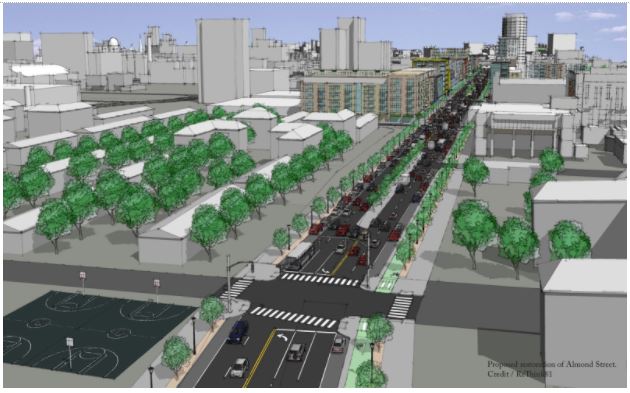Tearing down a viaduct on Interstate 81 through Syracuse, New York — part of a movement loosely called the “new urbanism” — could force some trucks to loop around the city’s eastern suburbs. And it is getting closer to reality.
The push to replace the elevated stretch of I-81 stalled during the pandemic. But an allocation by the state of New York and a recent visit to Syracuse by U.S. Transportation Secretary Pete Buttigieg makes clear that the plan has significant backing, increasing its chances.
In a recent report, the Congress for the New Urbanism compiled a list of mostly elevated interstate freeways that go through the heart of various cities, and said the 1.4-mile stretch in Syracuse was the road on the list most likely to be torn down. It would be replaced with a boulevard integrated into the existing grid system. Syracuse University would be due east of the new boulevard.
Tearing down the viaduct, the group said, “has the potential to herald a new generation of Highways to Boulevards projects, ones that seek to right historical wrongs and remedy spatial injustices. NYSDOT has the power to make the removal of I-81 through the center of Syracuse a reparative infrastructure investment that centers the residents who have lived with the burden of the highway. It only needs to follow through.”
But that is the prediction of an interest group. More significant was the visit to Syracuse by Buttigieg, where the Syracuse Post-Standard led its story on his comments by saying the transportation secretary “pledged his intention to rejuvenate the highway in a way that repairs the harm it has inflicted over the years.”
The harm Buttigieg referred to is a common theme in new urbanism movement: that elevated highways built years ago overwhelmingly sliced through minority areas, destabilizing them and leading to a wide range of negative consequences.
The news report said an environmental review is underway for the project and should be done next month. A preliminary environmental impact statement was released several years ago.
Also at the Buttigieg visit was New York’s senior U.S. Sen. Charles Schumer. The report said Schumer called the elimination of the I-81 viaduct through the city “his top transportation priority.”
“The decision to tear down the highway and build the community grid is the right decision,’’ Schumer was quoted as saying. “We might have to tweak it, make some changes here and there, but it’s the right decision.”
The report by the Congress for the New Urbanism notes that traffic that now goes straight through the city on the I-81 viaduct would be rerouted around the city on what is now known as the I-481 bypass. That bypass would instead be designated I-81.

The viaduct that would be torn down accounts for a relatively small portion of the stretch of 81 between where it now meets I-481 on the north and south sides of the city. According to studies done on the replacement project, going back to 2013, what is now 81 north and south of the viaduct to be torn down would either get a new interstate designation or be designated a state road with a new number.
Regardless, that middle portion of the 1.4-mile viaduct to be torn down means vehicular or truck traffic traveling from one side of Syracuse to the other would face red lights and cross traffic. The only way to avoid it would be to drive the loop on the east side of the city that is now 481 but would become 81.
There have been other steps taken to turn the project into reality. The Post-Standard reported that there is $800 million in the state’s most recent budget for the project, which is estimated to cost at least $2 billion.
Opposition to the project appears to be minor and fragmented. A website called Save 81 does not appear to have been updated for several years. A mall along the route in Syracuse’s downtown, Destiny Mall, has voiced its opposition as well. But the Buttigieg visit featured numerous local political leaders who all expressed support for the plan. Syracuse University also reportedly has endorsed the project.
The report by the Congress for the New Urbanism that said the Syracuse viaduct teardown was likely to be the first project to take place has a long list of other highways that it seeks to return to boulevards or something similar.
Not all of them would be significant truck routes. For example, a road in San Francisco along the Pacific Coast that had been turned into a pedestrian-only street during the pandemic, the Great Highway, would have that status become permanent.
Others could have greater impact on truck traffic, such as changes to the North Loop in Kansas City, Missouri, currently a six-lane highway north of downtown.
More articles by John Kingston
Seegrid adds RaaS model for companies looking to utilize robots
Latest Drivewyze offering speeds up inspection process at weigh stations
New regulations target truck emissions at Southern California warehouses












Peggy Ward
Please give the picture of the proposed boulevard a more realistic view. The path will not be so beautiful in reality.